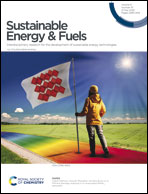Birnessite-clay mineral couple in the rock varnish: a nature's electrocatalyst†
Abstract
Hydrogen (H2) energy is produced by electrochemically splitting water molecules, and if produced economically, it will bring a paradigm shift in the development of sustainable energy systems. Several attempts have been undertaken in recent years to produce better electrocatalysts for the water oxidation process, with a focus on oxygen evolution reaction (OER) processes. A lot of work has gone into designing effective manganese-based heterogeneous catalysts for the water oxidation process, and a number of synthesized manganese oxides have been shown to have good alkaline OER activity. With the first-ever description of a natural material (rock varnish) constituted of birnessite (δ-MnO2) combined with clay minerals as a potential OER catalyst, the current work represents a typical scenario of the marriage between energy and the environment. This natural material having a current density of 10 mA cm−2 at a lower overpotential (η) of 312 mV and a Tafel slope of 46 mV dec−1 exhibits exceptional electrocatalytic performance on par or better than its synthesized Mn-based electrocatalysts. Rock varnish paves the way for developing highly active as well as stable manganese-based water oxidizing catalysts and may serve as a model for the biomimetic inspired synthesis of novel classes of MnO2-clay based composite materials as efficient water electrocatalysts for our future clean energy needs.



 Please wait while we load your content...
Please wait while we load your content...